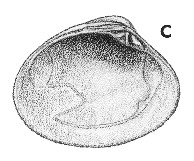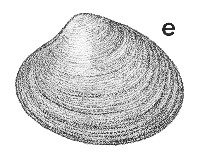
Revised descriptions of New Zealand Cenozoic Mollusca from Beu and Maxwell (1990)

 | Revised descriptions of New Zealand Cenozoic Mollusca from Beu and Maxwell (1990) | 
|
  (Pl. 45c): Castlecliff, Wanganui, Castlecliffian (GNS, early collection) |
  (Pl. 45e): Castlecliff, Wanganui, Castlecliffian (GNS, early collection) |
Beu & Maxwell (1990): Chapter 16; p. 343; pl. 45 c,e.
Synonymy: Cytherea (Callista) multistriata G. B. Sowerby II 1851 (in 1842-1887), p. 628; Cytherea (Callista) planatella of von Martens 1873, p. 44, not of Lamarck; Notocallista (Striacallista) multistriata ovalina Marwick 1938, p. 70; Callista multistriata; Paradione (Notocallista) multistriata
Type species of Striacallista Marwick, 1938
Classification: Veneridae: Pitarinae
Description: Small for family (25-35 mm long), thin and fragile, elongate-oval, with umbones at anterior 0.2-0.33 of length. Anterior and posterior margins narrowly rounded; ventral margin evenly curved; antero-dorsal margin straight; postero-dorsal margin straight (in narrow, subtrigonal specimens) to quite strongly convex (in rounded, inflated specimens, form ovalina, illustrated). Lunule long and narrow, flat, bounded by shallow groove. Sculpture of very many fine, closely spaced commarginal ridges, producing a silky sheen on fresh shells. Hinge narrow and thin; in left valve, with thin posterior cardinal tooth partly fused to ligamental ridge (nymph) above it, 2 other thin, widely separated cardinal teeth, and a prominent, narrow anterior lateral tooth; in right valve, with relatively thick, grooved, posterior cardinal, 2 other solid, protruding, upright, very closely spaced cardinal teeth (their orientation is characteristic of Pitarinae), and deep anterior lateral socket flanked by low ridges. Adductor scars approximately equal; pallial sinus wide, shallow, truncated by forward- sloping anterior edge.
Comparison: Marwick (1938) distinguished four shape variants of Notocallista multistriata in the Castlecliff beds, but named only one (ovalina) as a "subspecies"; these individual variants occur also in the modern fauna, and in our opinion are of no taxonomic significance. Older species placed in the subgenus Notocallista (Fossacallista) Marwick, 1938 differ mainly in their smaller size and subtly different muscle scars. The Tongaporutuan-Opoitian species N. (Striacallista) makoensis is more elongate and the Kapitean species N. (Striacallista) kapitea is shorter and more trigonal than N. multistriata.
Distribution: Waipipian-Recent; Recent, New Zealand (type of Cytherea multistriata); "bed 3c", Castlecliff, Wanganui (apparently basal shellbed(?) of the Shakespeare Cliff Sand), Castlecliffian (type of Notocallista multistriata ovalina). Common in late Pliocene to Pleistocene shallow, offshore, soft-bottom facies and shellbeds throughout New Zealand, but particularly in Nukumaruan siltstone of Hawke's Bay and Wairarapa, and Castlecliffian siltstone of Wanganui basin. N. multistriata is a common species in the soft-bottom infauna of the continental shelf around New Zealand today, below about 10 m; Recent specimens have a bright red-brown chequerboard pattern.
Cite this publication as: "A.G. Beu and J.I. Raine (2009). Revised
descriptions of New Zealand Cenozoic Mollusca from Beu and Maxwell (1990). GNS
Science miscellaneous series no. 27."
© GNS Science, 2009
ISBN
978-0-478-19705-1
ISSN 1177-2441
(Included with a PDF facsimile file
copy of New Zealand Geological Survey Paleontological Bulletin 58 in CD version
from: Publications Officer, GNS Science, P.O. Box 30368 Lower Hutt, New
Zealand)